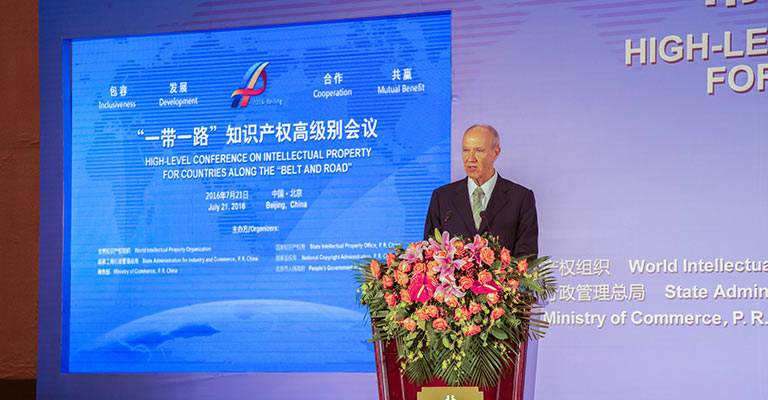High Level “Belt and Road” Conference Urges Closer IP Collaboration for Economic Growth
July 27, 2016
WIPO Director General Francis Gurry and China’s State Councilor Wang Yong opened the two-day High Level Conference on Intellectual Property for Countries Along the “Belt and Road” on July 21, 2016 in Beijing by welcoming the opportunity for participating countries to enhance cooperation in the field of intellectual property (IP) and to promote innovation.
The Conference takes place in the context of China’s “One Belt, One Road” initiative which seeks closer connectivity among central Asia, as well as with the rest of the world.

“The ‘Belt and Road’ initiative builds on historical and geographical ties to offer a wonderful shared opportunity for the economic, cultural and social development for the countries along the “Belt and Road” ,” Mr. Gurry said. He added that IP is an important part of the initiative.
“Intellectual property offers the opportunity for the transmission of ideas, science and technology and cultural products because it is the principle mechanism for the commercialization or market exchange of science, technology and cultural products,” the Director General told over 300 participants from some 60 countries.
A coherent approach
In welcoming the initiative, Mr. Gurry noted the significance for WIPO, as a multilateral organization, to be closely associated with a plurilateral economic arrangement . This is testimony to the openness of the “Belt and Road” initiative. The Director General said WIPO is “delighted by the opportunity given to us by the Chinese authorities to establish the clear relationship between the multilateral framework and the ‘Belt and Road’ and the opportunities presented by this initiative.”
Mr. Gurry said “this would ensure coherence in the architecture for the implementation of intellectual property worldwide. The multilateral framework offers a very good platform for much of the cooperation in which countries of the “Belt and Road" may engage.”
Leveraging WIPO tools
The Director General outlined the multilateral platforms that will help to enhance cooperation and the exchange of ideas and cultural products among the Belt and Road countries. The first is WIPO’s global intellectual property services, which offer an opportunity for enterprises in the region to achieve IP protection in multiple countries. He also pointed to WIPO’s databases which offer opportunities for improving the quality of information that is available to IP offices. Mr. Gurry also mentioned WIPO’s multilateral legal framework that includes over 20 IP treaties administered by the Organization.
China’s State Councilor Wang Yong said this Conference highlights the opportunities and challenges for countries along the “Belt and Road” in the IP sector aimed at enhancing cooperation. This, he said, “is very important for the development of the ‘Belt and Road’ and also to regional innovation and development.”
Mr. Wang said China attaches high importance to the development of IP throughout the country and pledged his Government’s continued commitment to innovation-driven economic development. This, he noted, is relevant to the development of cooperation among “Belt and Road” countries.
Reform for competitiveness and innovation
The State Councilor said China will continue to implement innovation-driven growth strategy and a national IP strategy aimed at increasing China’s IP competitiveness. China, he said, will focus on prioritized reforms to implement very effective and stringent protection for IP to incentivize innovation.
He said that the Chinese government wishes to engage with countries in the “Belt and Road” to conduct consultations and joint planning and institutional development based on the principle of win-win and respecting the concerns and interests of economies along the “Belt and Road” engaging in higher level and more profound IP cooperation.
In this respect, he said economies of the “Belt and Road” need to work together to prioritize IP as a system to promote innovation and to share the benefits of innovation. Mr. Wang also urged countries of the “Belt and Road” to engage in closer cultural exchanges through close cooperation in the field of copyright, citing book publishing and other cultural productions “to benefit from each other’s wisdom.”
No innovation without protection
“We need to step up the protection of IP. Without protection, there is no incentive to engage in innovation,” Mr. Wang emphasized. If people lose their motivation to create and innovate, he said, the economy and trade will also suffer.
“Without protection, there is no incentive to engage in innovation.”– State Councilor (China) Wang Yong
Mr. Wang also called for greater international judicial cooperation and firm action against infringers. Penalties will deter infringers, he pointed out. Lastly, Mr. Wang said countries of the “Belt and Road” need to accelerate formulation of national strategies that will facilitate closer cooperation among the countries, including in:
- cooperation in IP-related services,
- harmonization of IP rules,
- inter-operability of databases, and
- joint human resources training.
He said deepening cooperation in IP and promoting regional innovation is the joint mission and responsibility of countries around the Belt and Road.
Conference themes
The Conference covered a number of themes relating to the importance of IP to socio-economic development, innovation driven policies and strategies, balance and inclusiveness in the development of national and international legal frameworks, the role of IP rights in realizing the value of innovation and creativity and a vision for cooperation between Belt and Road countries.
Participants came from countries of the Belt and Road as well as significant participation by China, including 25 provincial IP offices and 19 municipal IP offices such as Beijing, Shanghai and Chongqing.
The Conference was co-organized by WIPO, China’s State Intellectual Property Office, China’s State Administration for Industry and Commerce, China’s National Copyright Administration, China’s Ministry of Commerce and the People’s Government of Beijing Municipality.